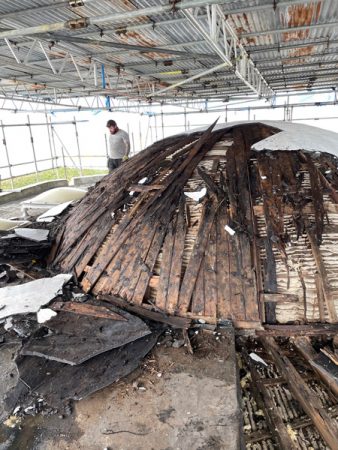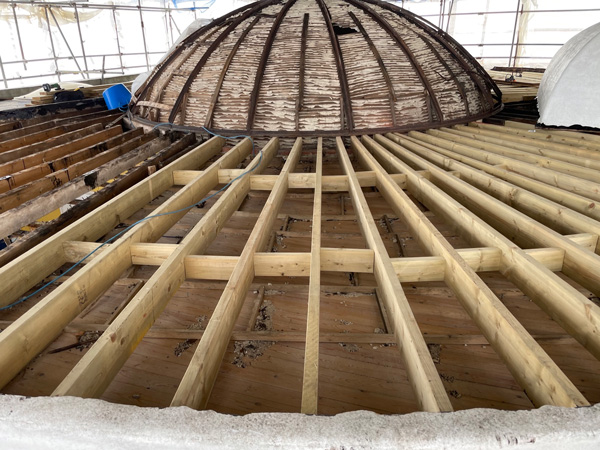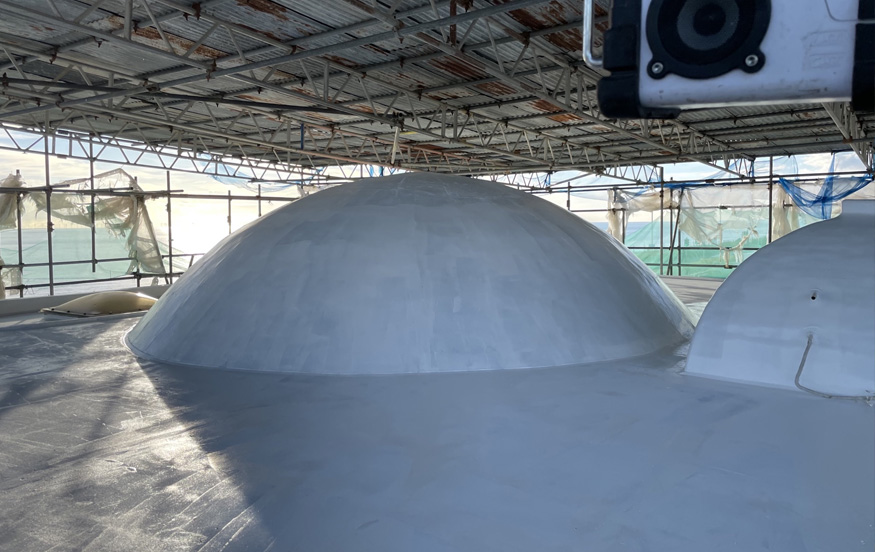Although mastic asphalt is one of the world’s oldest and most traditional roofing materials, it can sometimes be wrongly perceived by specifiers and clients as a one-dimensional waterproofing product that is only available in a standard black finish. But like many long-lasting, tried and tested materials, mastic asphalt is being re-imagined, modified and re-examined as a highly relevant building material for today.
A residential project carried out by Brighton-based Oxley Asphalte certainly illustrates this. A family run business, Oxley Asphalte is run by Jack Oxley and his wife Rebecca, and the company has recently become a contractor member of the Mastic Asphalt Council (MAC).
 The project involved the waterproofing of a distinctive residence in Saltdean, Brighton. Built sometime in the 1920s, the property is known as ‘The Dome’ as the roof features a distinctive dome shape. The dome was originally constructed in copper but it was relaid with mastic asphalt in the 1980s. Over this time, asphalt provided effective waterproof protection and the homeowner wanted to refurbish the dome using mastic asphalt once again due to its durability.
The project involved the waterproofing of a distinctive residence in Saltdean, Brighton. Built sometime in the 1920s, the property is known as ‘The Dome’ as the roof features a distinctive dome shape. The dome was originally constructed in copper but it was relaid with mastic asphalt in the 1980s. Over this time, asphalt provided effective waterproof protection and the homeowner wanted to refurbish the dome using mastic asphalt once again due to its durability.
The residential property is closely located by the coast, so it was essential that the waterproofing system was able to provide effective protection against high winds and heavy rain. Wind gives roofs a beating, especially buildings such as this which have more exposed roofing surfaces. Vibration caused by wind can lead to material fatigue and crack formation.
Hail and snow can also cause mechanical roof damage, whilst freeze/thaw cycles are a frequent source of breakdown for many roofing materials. Water expands when it freezes and can therefore enlarge cracks. Mastic asphalt is one of the toughest, most durable waterproofing membrane systems available, and one that will withstand our increasingly destructive weather in the long-term.
Another major advantage of using mastic asphalt is that a seamless system ensures there is no threat of water penetration through any joints, laps or seams. Spot repairs can also be carried out if needed, eliminating the need for costly wholesale replacement.
Oxley Asphalte were on site for a total of four weeks and the refurbishment involved the installation of a total of 110m2 of mastic asphalt, which comprised an 80m2 area around the dome and the dome itself which was 30m2.
The existing asphalt was stripped away and new mastic asphalt installed. To enable operatives to work at the top of the dome, Oxley Asphalt created a wooden platform to allow access. Once the mastic asphalt was applied, two coats of a solar reflective paint were applied to achieve the desired finished appearance.
 Though the life expectancy of mastic asphalt has been estimated at 50-60 years by the Building Research Establishment (BRE), there are many cases of asphalt roofs providing effective waterproof protection for up to 80-100 years. In terms of quality of workmanship, mastic asphalt is one of the few construction activities still regarded as a ‘craft trade’.
Though the life expectancy of mastic asphalt has been estimated at 50-60 years by the Building Research Establishment (BRE), there are many cases of asphalt roofs providing effective waterproof protection for up to 80-100 years. In terms of quality of workmanship, mastic asphalt is one of the few construction activities still regarded as a ‘craft trade’.
The skilled work involves ensuring that asphalt is at the correct temperature, and then spreading it using traditional techniques to coat the surface. A thermoplastic material that changes shape when heated, mastic asphalt cures to form a hard, durable, finished product to suit a wide range of applications.
To maintain the industry’s reputation and ensure high quality applications for every single project, only trained applicators are permitted to install mastic asphalt under the Mastic Asphalt Council’s strict rules. Being a MAC member enhances the reputation of a contractor and gives a badge of quality and assurance that they meet very highest of standards with regards to factors such as trading and credit history, insurance policies and quality of workmanship.
This article featured within the April 2023 edition of RCi magazine – click here to view the article.

